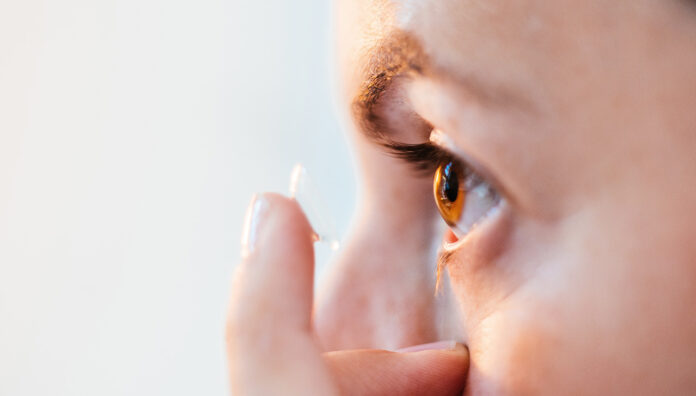A novel therapy under investigation could see pharmacists playing a greater role in helping patients to manage some common eye conditions.
Researchers at the University of New South Wales (UNSW) Sydney are collaborating with Uka Tarsadia University’s Maliba Pharmacy College in India to investigate contact lenses as drug delivery systems to control, manage and treat various ocular diseases.
Key points:
|
Microbiologist Professor Mark Willcox from UNSW’s School of Optometry and Vision Science, who is co-leading the study with optometrist Dr Alex Hui, said contact lenses that deliver drugs could theoretically be used to treat diseases such as glaucoma, dry eyes, conjunctivitis, myopia development and macular degeneration.
The Indian researchers had investigated drug delivery through contact lenses for a number of years, he said.
‘They’re very interested in the pharmacokinetics and pharmacodynamics issues,’ Prof Willcox told Australian Pharmacist.
‘They’ve looked at everything from non-pharmaceutical interventions for conditions like dry eye, all the way to delivering glaucoma medicines.’
The partnership will allow for collaborations between pharmacists, engineers, optometrists and chemists, said Dr Hui, also from the UNSW School of Optometry and Vision.
‘It comes at a critical time where research interest in managing diseases such as dry eye and myopia development is increasing both from clinicians and patients,’ he said.
Therapeutic contact lenses would either contain a drug and be prescribed by an eye specialist and dispensed by a pharmacist, or soaked in a dose of the pharmaceutical, as with traditional contact lens solution, which could be purchased from a pharmacy.
In regional and rural areas where eye specialists were in shortage, Dr Hui said pharmacists could be the practitioners tasked with not only dispensing but also placing the lenses in patients’ eyes.
Seeing solutions
Eye drops, which are the traditional treatment for the vast majority of front-of-eye diseases, can be difficult to apply and lead to a lack of compliance, Dr Hui said.
They also often do not deliver enough of the drug or have the drug resident on the eye for long enough.
Using contact lenses could address these issues, he said.
‘Thinking about glaucoma, it usually requires people to use eye drops daily for the rest of their lives, and people often forget,’ he said.
‘We can potentially improve compliance by tying their treatment in with something they can’t really ignore – their contact lenses.’
Professor Jeff Hughes MPS, from Curtin University’s School of Pharmacy and Biomedical Sciences, told AP that another issue was the considerable dose of eye drops that goes down the nasal passage and is absorbed systemically.
‘This can cause health issues,’ he said.
‘For example, some drugs used to treat glaucoma can stimulate the gut and cause diarrhoea, while in asthmatics they may cause bronchial spasms.’
Dr Hui echoed this and said the pharmacokinetic profile of eye drops was ‘not ideal in most cases’.
‘The oft-cited statistic is that about 5% or 10% of the active ingredient within an eye drop actually gets to where we want it to get to,’ he said.
‘If we can improve that bioavailability, we’ll have less waste and less systemic absorption.’
Looking to the future
While contact lenses that address minor eye issues, such as dry eye or hay fever-related conjunctivitis, would be a significant advance, delivering the right volume of medicine over time for people with more serious conditions presented a considerable challenge, Prof Hughes said.
‘Does a lesser dose of medicine over a longer period result in more stable intraocular pressure?’ he said.
‘Another issue would be stabilising multiple medicines together for people using more than one eye drop.
‘However, all problems can potentially be solved,’ he added.
Dr Hui said this was the ‘biggest challenge so far’.
‘For the most part, lenses aren’t designed to release drugs,’ he said.
‘If you test them in the laboratory, within 10 minutes to half an hour all the drug that they’re going to release has been released. You can’t see too much of an advantage compared to an eye drop in that situation from a pharmacological perspective.
‘But if you can extend that and tailor the drug release, instead of a person having to use drops every 4 hours or every hour, they could just put a lens on and it would release the same amount of the drug over the course of a day. That’s the goal.’
Another challenge was that not all people can, or want to, wear contact lenses, Prof Willcox said.
‘Associated with that is the complications that are generally found with contact lenses,’ he said.
‘Inflammatory diseases or inflammatory reactions to contact lenses, as well as infections of the eye – they’re all a routine part of clinical practice when you fit these lenses.’
While there are currently no commercially available contact lenses for drug delivery, Dr Hui said they are used after laser eye surgery to help with the healing process.
‘That’s probably the closest real-world area where contact lenses are being used with drugs,’ he said.
‘The rest of the time, when we prescribe drugs for people who wear contact lenses, we tell them to put the drops in first and wait 10 minutes before putting the lenses on, to avoid cross contamination.’



 Pharmacists have always prescribed, but they have the potential to prescribe much more
Pharmacists have always prescribed, but they have the potential to prescribe much more



 Sponsorship information
Sponsorship information


 Talking to patients who have questions
Talking to patients who have questions





